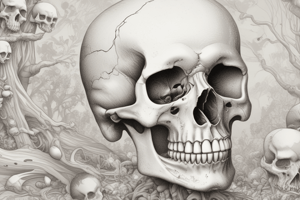Podcast
Questions and Answers
What is the primary characteristic of bone-forming tumors?
What is the primary characteristic of bone-forming tumors?
- They produce cartilage tissue
- They produce muscle tissue
- They produce bone tissue (correct)
- They produce nerve tissue
Which type of bone-forming tumor is most common in the long bones?
Which type of bone-forming tumor is most common in the long bones?
- Osteoma
- Fibroma
- Osteosarcoma (correct)
- Chondroma
What is the primary goal of treatment for osteosarcoma?
What is the primary goal of treatment for osteosarcoma?
- To improve mobility and range of motion
- To relieve pain and swelling
- To reduce the risk of recurrence
- To remove the tumor and preserve function (correct)
What is the typical location of osteoma tumors?
What is the typical location of osteoma tumors?
What is the primary difference between osteoma and osteosarcoma?
What is the primary difference between osteoma and osteosarcoma?
What is the purpose of staging in the diagnosis of bone-forming tumors?
What is the purpose of staging in the diagnosis of bone-forming tumors?
What is the typical treatment for benign osteomas?
What is the typical treatment for benign osteomas?
Flashcards are hidden until you start studying
Study Notes
Characteristics
- Bone-forming tumors are a type of primary bone tumor that produces bone tissue
- Can be benign or malignant
- Classified into two main categories: osteoma and osteosarcoma
Osteoma
- Benign bone tumor
- Most common type of bone-forming tumor
- Typically occurs in the craniofacial bones (e.g. skull, face)
- Slow-growing and asymptomatic
- Treatment usually not necessary, but may be removed for cosmetic reasons
Osteosarcoma
- Malignant bone tumor
- Most common type of primary malignant bone tumor
- Typically occurs in the long bones (e.g. femur, tibia)
- Can occur in any bone, but most common in children and adolescents
- Symptoms include pain, swelling, and limited mobility
- Treatment typically involves surgery, chemotherapy, and radiation therapy
Diagnosis
- Imaging studies (e.g. X-ray, CT, MRI) to visualize the tumor
- Biopsy to confirm diagnosis and determine tumor type
- Staging to determine extent of tumor spread
Treatment
- Benign osteomas: observation or surgical removal
- Osteosarcoma: multimodal treatment including surgery, chemotherapy, and radiation therapy
- Goals of treatment: remove tumor, preserve function, and improve survival rate
Studying That Suits You
Use AI to generate personalized quizzes and flashcards to suit your learning preferences.




